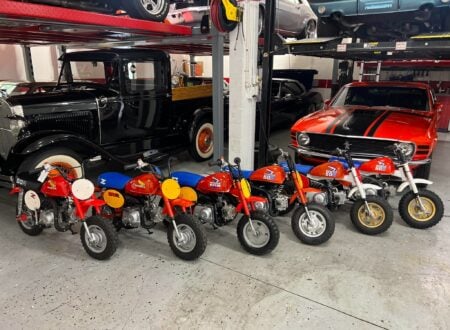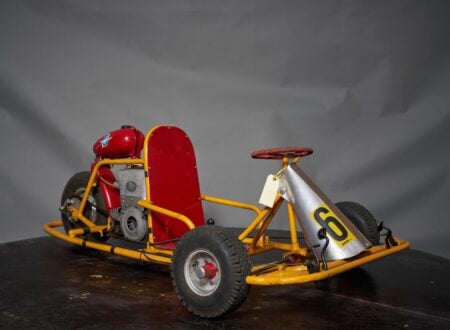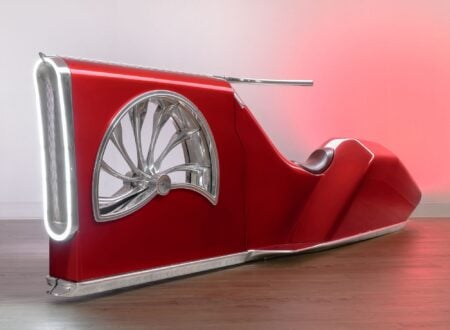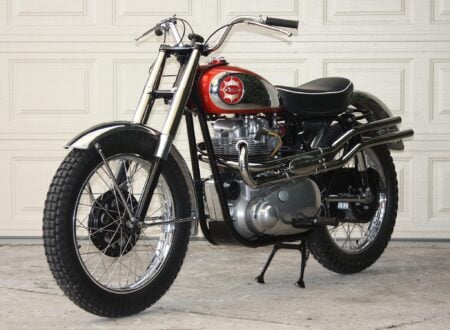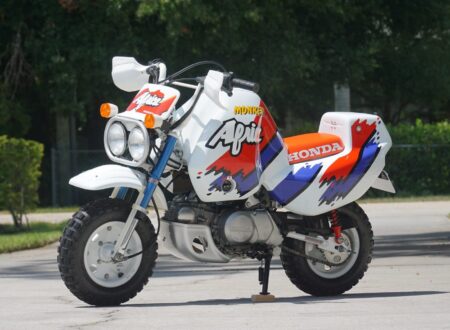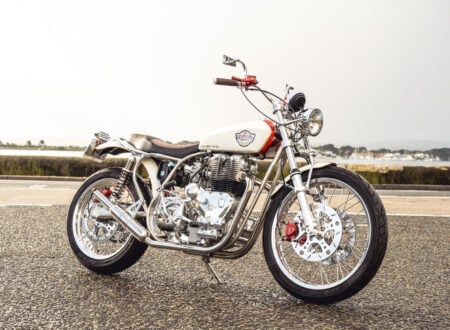This is a custom-built Harley-Davidson XR883 custom that was made by the team at the Gasoline Motor Co. in Sydney, Australia. As you can see, it’s closely based on the styling of the XR750 that dominated flat track racing for decades.
The original XR750, as well as the XR883 you see here, are nimble motorcycles that are lightweight by Harley standards and great fun to ride – whether you’re blasting around a dirt oval or cutting your way through morning traffic.
Fast Facts – A Custom Harley-Davidson XR883
- The Harley-Davidson XR750 was developed quickly to address the changes to AMA Grand National Championship Class C rules that governed flat track racing in the United States. The rules had previously limited overhead valve engines to 500cc, while flathead (side valve) engines could be built up to 750cc.
- These rules had allowed the Harley-Davidson KR 750 to dominate the series for many years, despite its by-then antiquated side valve design. In 1969 the rules were slated to change, and Harley needed a competitive overhead valve 750cc engine ASAP.
- They turned to the Sportster model and reduced the engine displacement from 900cc down to 750, then worked on developing the engine for power. A frame from the KR-series was repurposed for the bike and it started racing in 1970. It would become the most successful motorcycle in the history of flat track.
- In recent years many have taken to building road-legal custom motorcycles using a similar recipe to the original XR750. They’re called “Street Trackers” and they typically use Sportster engines in various displacements.
The Harley-Davidson XR750
In the late 1960s, Harley-Davidson decided to develop a new racing motorcycle to replace the aging KR model. The XR750 was designed specifically for dirt track racing, also known as flat track racing, a popular form of motorcycle racing in the United States. The bike was introduced in 1969 as a successor to the highly successful Harley-Davidson KR750.
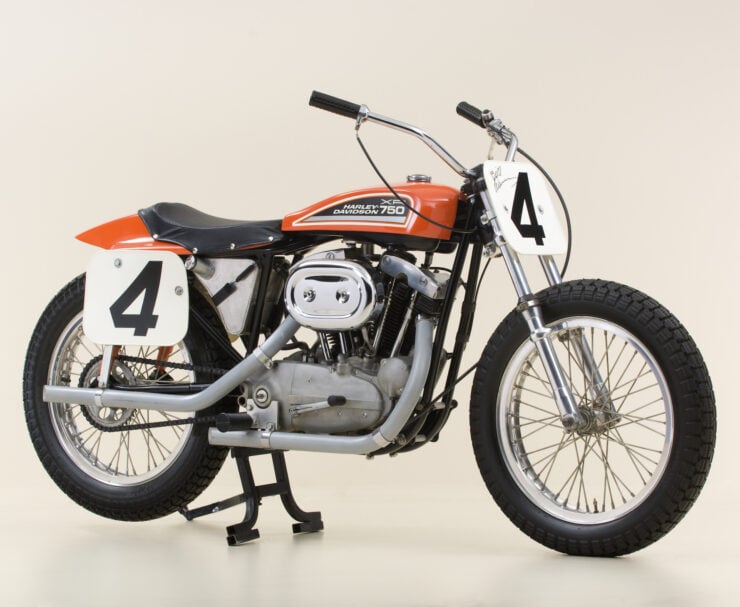

The development of the XR750 had been directly triggered by changes to the rules for AMA Grand National Championship Class C competition. The rules had previously limited overhead valve engines to 500cc, while flathead (side valve) engines could be built up to 750cc.
As a result of these rules, the more advanced British motorcycles with 500cc and 650cc OHV engines were essentially sidelined by the less advanced flathead (or side valve) Harley-Davidson KR 750. This was all set to change from the 1970 season onwards, and Harley needed a new race bike to remain competitive.
Harley-Davidson’s racing manager Dick O’Brien and his team set to work. They took the OHV 900cc V-twin out of the Sportster and modified it with shorter connecting rods to bring the displacement down while trying to bring the performance up via a range of performance upgrades.
Many Harley-Davidson KR series parts were carried over for the new model initially, including a frame from the KR-series bikes, and it was given Ceriani front forks and twin Girling rear shocks. A very simple flat track style fuel tank and seat were designed and made from fiberglass, and the bike was sent out to do its worst.
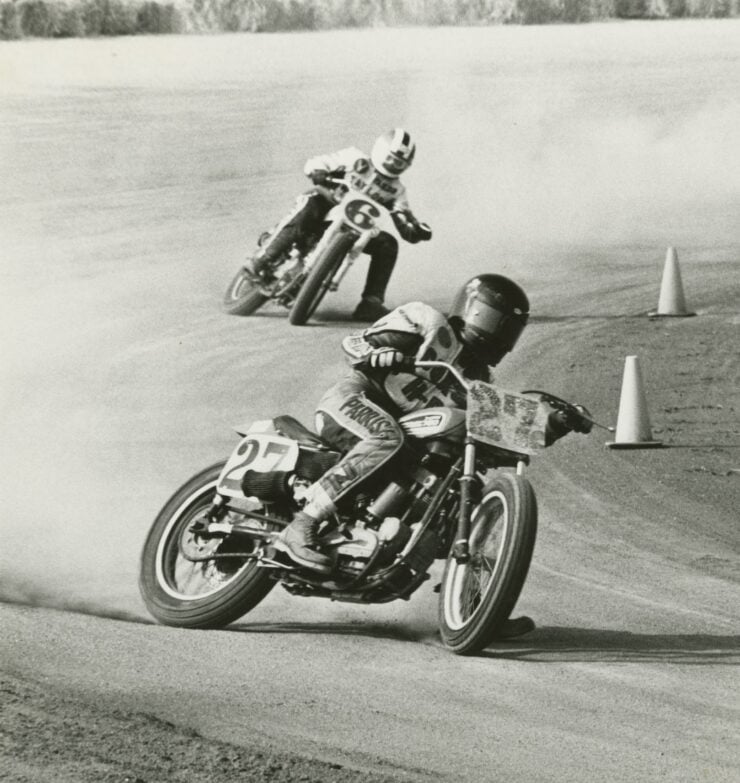

Although no one knew it at the time, their rapidly developed parts bin special would be come the most successful motorcycle in the history of flat track racing, after an initial teething period to work out the kinks.
The Harley-Davidson XR883 Shown Here
The bike you see here started out as a 2018 Harley-Davidson XL 883 Super Low Sportster – although you’d never know it by looking at it now. Just as the original XR750 was developed using a Sportster engine, so was this one, except this bike was made using the more modern Harley-Davidson Evolution V-twin.

Sportsters have long been a popular target by those seeking a donor for a street tracker custom. The aftermarket parts support is excellent and many of the required parts can be bought, plus the mechanical simplicity of the bike makes it far easier to work on.
The XR883 you see here was built by Jason Gasoline and the team at Gasoline Motor Co. in Sydney, Australia. Jason founded the business back in 1994, when many of us were still in short pants (or diapers), and in the years since he’s built it into an Australian motorcycle institution.
Turning a Sportster into a street tracker is an involved job that requires the builder to modify the frame, engine, fuel tank, seat, exhaust, handlebars, suspension, wheels, tires, and more. It’s not one of those weekend customs a person can bang out with a few bolt-on parts.

The team at Gasoline spent weeks working on this Sportster to turn it into an XR883, it keeps the original frame and engine, now both modified, and added new exhausts, a new flat tracker fuel tank and seat, an LED headlight and mini indicators, and they performed a belt to chain final-drive conversion.
The original front and rear wheels were replaced with a correct pair of 19″ spoked alloy wheels front and back, and unlike the original XR750 this one has a front brake – essential for safety on the road.
A new rear license plate holder has been fitted as well as a new oil tank and a remote fuel pump. The bike is now being sold out of the Gasoline Motor Co. shop in Sydney on the Collecting Cars platform.
If you’d like to read more about this unusual custom or register to bid you can visit the listing here.
Images courtesy of Collecting Cars + Gasoline Motor Co.

Articles that Ben has written have been covered on CNN, Popular Mechanics, Smithsonian Magazine, Road & Track Magazine, the official Pinterest blog, the official eBay Motors blog, BuzzFeed, Autoweek Magazine, Wired Magazine, Autoblog, Gear Patrol, Jalopnik, The Verge, and many more.
Silodrome was founded by Ben back in 2010, in the years since the site has grown to become a world leader in the alternative and vintage motoring sector, with well over a million monthly readers from around the world and many hundreds of thousands of followers on social media.

